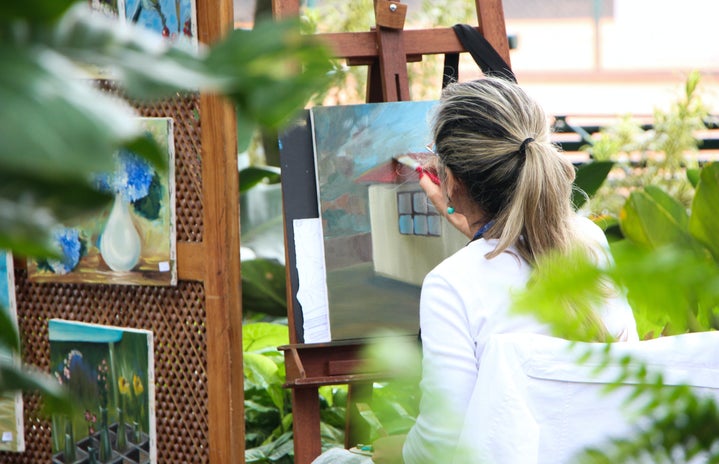As soon as I stepped into MuSA, The Museum of Art of University of Puerto Rico, Mayagüez Campus (UPRM), it felt surreal; the fresh smell of paint, the gardeners along the other interns working on the beautiful patio, and the camera men from “Prensa RUM,” gave it a dreamlike quality. Truly, it felt like the preamble of the grand opening of a big museum in Europe. In reality it’s something quite similar, because I was stepping into the tour of MuSA and that is quite a big deal. Guiding the tour was the very kind, gracious, and funny Melissa M. Ramos Borges, Historian first and foremost, who was invited to be the Curator of the art pieces. Ramos makes you feel completely at ease when being around her. What brought her here was a friend in common with Zorali de Feria, the director and administrator of the museum.
Accompanied by a group of art student interns, I heard in awe all Ramos had to say about the museum and the pieces, and all that has been done since she started working on it. She investigated and researched UPRM and what has happened since its early years, focusing on the art professors’ pieces. The first exhibit room at MuSA is dedicated to the Museum of Reproductions. Artistic production on campus started with this Museum of Reproduction in charge of Professor Alvare Cerbela whose purpose, with the project, was to bring art closer to the people of Mayagüez by introducing reproductions of classic sculptures, as well as two very important paintings made by Juan Montoro, a copyist from “Museo del Prado.”
The second exhibit room displays the exploration of the art program created on campus in the 1930’s by Maria Luisa Benez de Castillo, an artist as well as teacher. MuSA has two of her paintings, one of which is named “Tertulia de los Pescadores.” The paintings MuSA has date from her time as a professor at the university. Another artist, Geralys Saint Germain, who did many ceramic pieces, also published a book about his experiments with clay in Puerto Rico.
In the next room, we indulge in Regina Silveira’s work called “Quince Laberintos” which plays with linear perspective on a bi-dimensional surface. Her husband, Julio Plaza, changed the concept of a traditional book and created a different yet extraordinary artistic representation of it on both his pieces displayed in MuSA; one of them named “Objetos.”
We were then introduced to “La Nueva Cepa” which is about new professors who entered the Art program in the eighties. They were all disciples, either directly or indirectly, of Maria Luisa. Some of them include Evelyn García, whose work on colography was inspired by a personal camping experience she once had and it’s all portrayed in her piece. In collaboration with José Alicea, the piece “Homenaje a la Planta de Bejuco” was created on handcrafted paper.
Another great artist found in this room is Felix Zapata whose piece “Oasis” is very admirable. Another piece, which was very curious, is Ivette Cabrera’s “Los seres que me habitan,” which displays a whole character’s face composed of other little faces. Melissa M. Ramos describes this particular piece as “something out of a fairy tale.”
Carlos Fajardo is one of the artists that stands out the most, especially for his piece “Bodegón,” embracing a more pop-art style. This piece is composed of an art history collage made with cut-outs from newspapers, offering a personal critique to the socio-political situations happening at the moment. His unique, funny, and daring personality seeps through his other paintings in MuSA which, I promise you, can be easily identified. One of his most recent paintings, “El Comercial,” features the picture of Che Guevara but twists it around into a promotion for shampoo with the phrase “revoluciona tu cabellera,” leaving a unique perspective to his artistic work.
In the last room of MuSA, Marcos Irizarry’s work, which was previously displayed at the Rector’s house and is part of the permanent collection of the university, is displayed. Ramos expressed “es el principio y el fin.” Other emblematic artists in this museum are Agustín Stahl, who created a watercolor painting of Puerto Rico’s flora, and Susana Espinoza who made the piece “La Isla Recreada.”
Melissa Ramos, the colegial alumni addressed me, “the most interesting factor of the exhibition is that it focuses more on artists that don’t usually spend their time in the limelight, the typical hub of art in the island lies in San Juan, and it’s refreshing to explore art of the periphery.” She added that what makes this exhibition truly special is that it’s composed of artists who are also dedicated to the academia. None of this would have been possible without the small team of passionate people that worked together to make this possible like Andrea Bauzá, who was in charge of designing the exhibitions’ montage.
MuSA’s grand opening will be held on Thursday, February 11th at 6pm and the whole crew is very excited to receive everyone. It is absolutely wonderful to know that the University of Puerto Rico, Mayagüez Campus supports true artistic talent, especially talent that has grown in our island. You will not be disappointed by visiting our museum; you’ll find at least one piece of art that truly touches you, just as I found mine.


